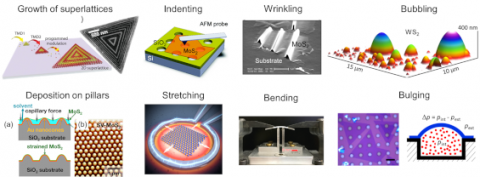Stretchable Flatland

Two-dimensional (2D) crystals are atomically thin layers that can be easily isolated from the so-called van der Waals crystals, where planes of strongly bonded atoms are held together by dipolar forces. Since the discovery of graphene, the prototypical 2D crystal, many other 2D materials have been isolated and are likely to remain one of the hottest topics in condensed matter physics and materials science. The interest of fundamental and applied sciences for 2D materials grounds on the wealth of unusual and alluring electronic, optical, transport and magnetic properties these materials exhibit, stemming from the lowered dielectric screening and from the enhanced quantum effects that arise at the few-atom thick limit.
The inherent all-surface nature of 2D crystals and their incredible mechanical flexibility and robustness have offered the possibility to subject them to high mechanical deformations, engendering strains larger than 10%. Such strain fields induce major modifications in the electronic, optical, magnetic, transport, and chemical properties of 2D materials, leading to the observation of a plethora of intriguing phenomena, ripe with new physics and novel opportunities.
A recent review article by Elena Blundo in collaboration with Antonio Polimeni and Marco Felici, and colleagues at the National Research Council (Emmanuele Cappelluti and Giorgio Pettinari) surveys the effects of strain in 2D crystals. This review —published in Applied Physics Reviews and featured as Editor’s Pick— shows the great potential of strain to modify the properties of 2D materials and to induce therein fascinating effects. The authors review the increasingly inventive approaches proposed to induce strain in 2D crystals, either based on diverse growth techniques, on devices able to bend, bulge, stretch, or indent atomically thin membranes, or on endogenous phenomena (such as gas trapping or hydrogen caging). These methods provide a precious tool to understand the mechanical and electronic properties of the investigated materials, as well as a means to deliberately modify those properties. The authors also report on the manifold uses of strain in 2D crystals for inducing piezoelectric and exotic pseudomagnetic fields, for creating single-photon sources for quantum optics applications, and for opening new opportunities for valleytronics, flextronics and straintronics, just to mention a few examples. All these effects take place and can be tuned at the micro- and nanometer scale, thus prompting new exciting prospects for nanotechnologies.
Authors:
Elena Blundo, Antonio Polimeni, Marco Felici
Reference:
